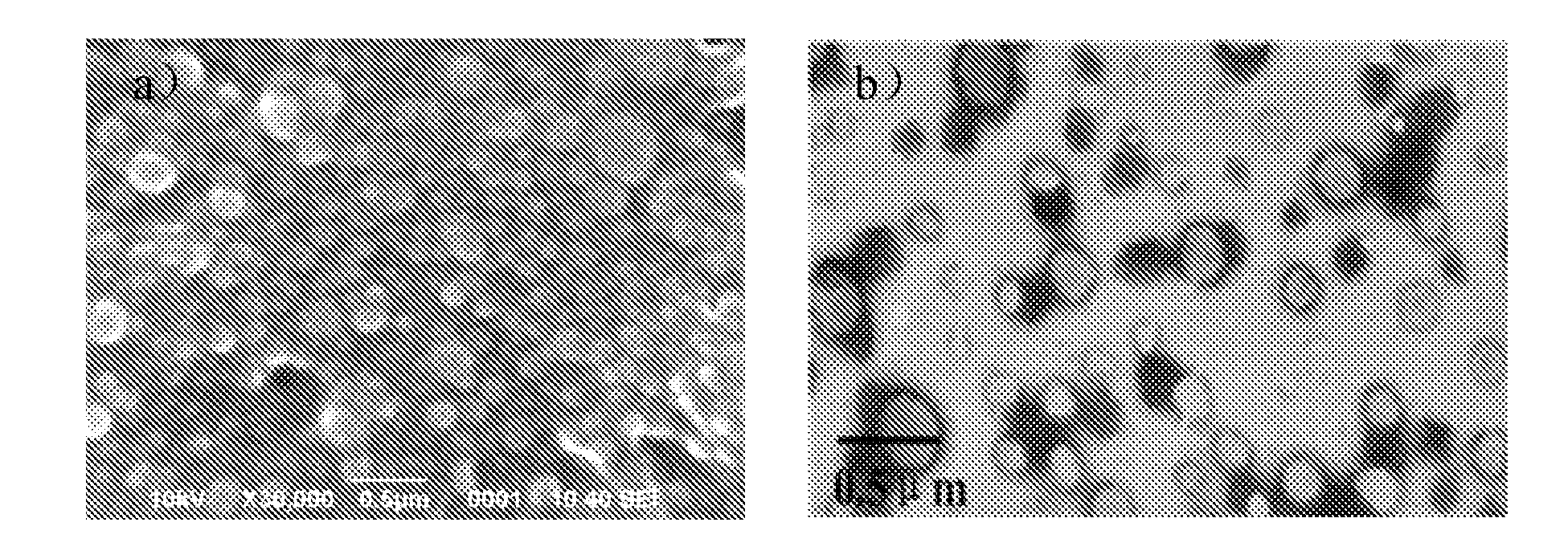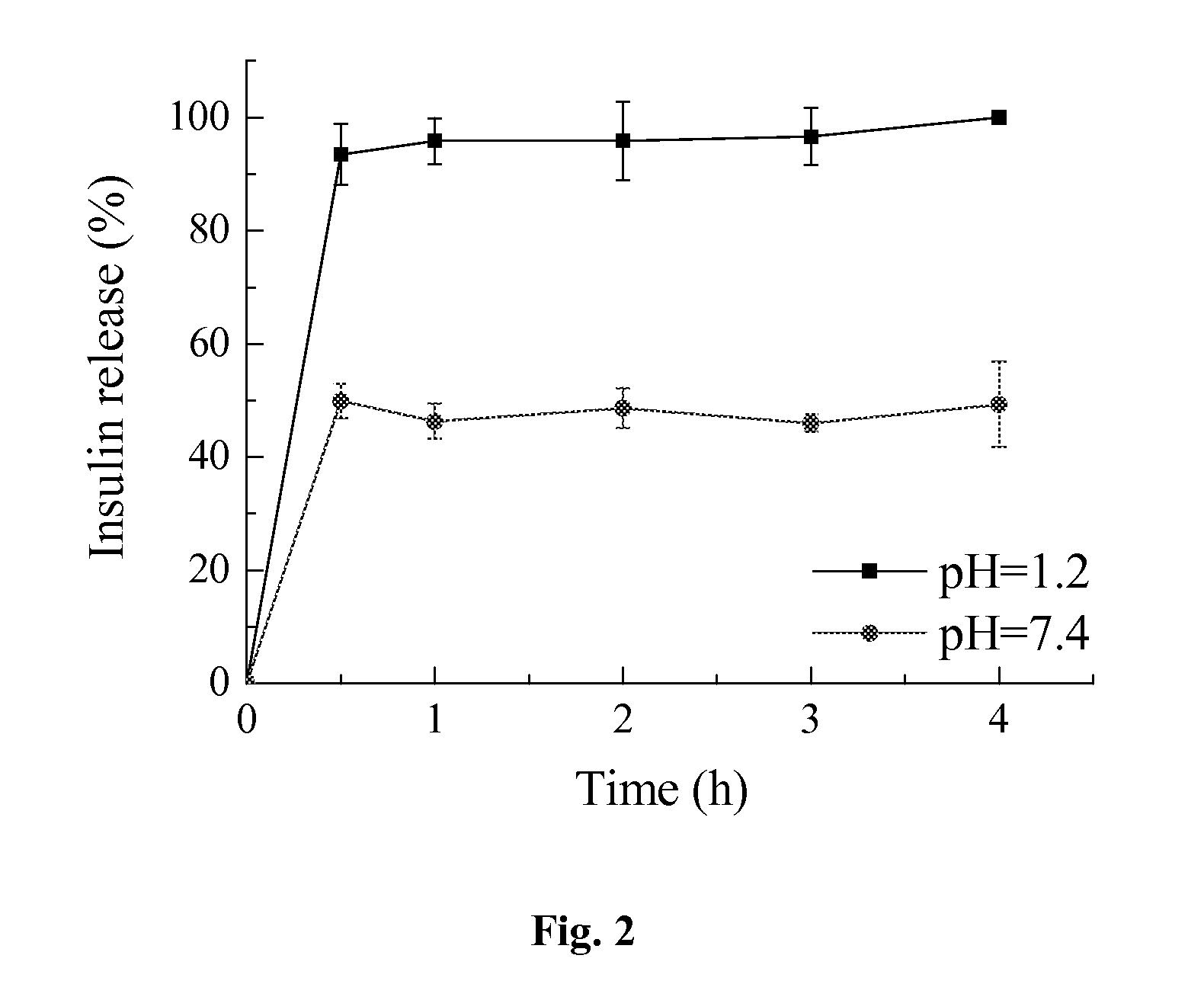Enteric-coated capsule containing cationic nanoparticles for oral insulin delivery
- Summary
- Abstract
- Description
- Claims
- Application Information
AI Technical Summary
Benefits of technology
Problems solved by technology
Method used
Image
Examples
example 1
Preparation of Insulin-Loaded Cationic Nanoparticles
[0024]The preparation of nanoparticles is carried out by the multiple emulsions technique. Briefly, 1 mL of an aqueous solution of insulin (1 mg / mL) is first emulsified, by sonication at a power of 40 W for 30 s, in methylene chloride (5 mL) containing 100 mg of polymers (PLGA / Eudragit RS, 50 / 50). The resulting first emulsion is thereafter poured into 40 mL of a polyvinyl alcohol aqueous solution (1%) and sonicated at a power of 60 W for 1 min, involving the formation of the multiple emulsions. After evaporation of methylene chloride under reduced pressure, the nanoparticles are collected and washed three times by centrifugation at 20,000 rpm for 10 minutes. After prefreezing of the resultant dispersion (concentration of nanoparticles and cryoprotectant are 1% and 1.5%, respectively) at −20° C. overnight, this mixture is then subjected to vacuum freeze drying.
TABLE 1Mean particle SizeTrehalose %(nm)PDIZeta Potential (mV)before free...
example 2
Characterization of Insulin-Loaded Cationic Nanoparticles
[0026]Generally, nanoparticles have greater intracellular uptake compared with microparticles, and are available to a greater range of biologic targets due to their smaller size and mobility. Decreasing the nanoparticles size leads to an increased absorption of insulin by intestinal cell. Many formulation and process parameters affecting nanoparticles size are studied in the present invention in the multiple emulsions solvent evaporation method, such as sonication time, polymer amount, surfactant concentration and the volume of oil phase and external aqueous phase, etc. It is believed that varying the volume of external aqueous phase is the easiest way to modulate the size of nanoparticles of the present invention. As shown in Table 2, decreasing the volume of external aqueous phase could decrease the size and increase zeta potential value of nanoparticles. The smaller the volume of external aqueous phase is, the greater the p...
example 3
Zeta Potential of PLGA / RS Nanoparticles in Different pH Conditions
[0028]The zeta potential value is an important particle characteristic as it can influence both nanoparticle stability and mucoadhesion in GI conditions. Mucoadhesion can be promoted by a positive zeta potential value. The mucus layer itself is at a neutral pH value with an anionic polyelectrolyte. Consequently, the presence of positively charged groups on the nanoparticles could lead to electrical charge interactions between the mucus and the particles. As shown in Table 3, the zeta potential value and size of the PLGA / RS nanoparticles have been investigated in the pH range 1.2-7.2, mimicking the GI physiological conditions. It is clear that pH value of medium plays an important role in the zeta potential value of nanoparticles. Generally, the quaternary ammonium cations in RS polymer are permanently charged, independent of the pH of their solution. Insulin (PI=5.4) becomes a positively charged molecule at pH 1.2. Th...
PUM
| Property | Measurement | Unit |
|---|---|---|
| Fraction | aaaaa | aaaaa |
| Fraction | aaaaa | aaaaa |
| Time | aaaaa | aaaaa |
Abstract
Description
Claims
Application Information
 Login to View More
Login to View More - R&D
- Intellectual Property
- Life Sciences
- Materials
- Tech Scout
- Unparalleled Data Quality
- Higher Quality Content
- 60% Fewer Hallucinations
Browse by: Latest US Patents, China's latest patents, Technical Efficacy Thesaurus, Application Domain, Technology Topic, Popular Technical Reports.
© 2025 PatSnap. All rights reserved.Legal|Privacy policy|Modern Slavery Act Transparency Statement|Sitemap|About US| Contact US: help@patsnap.com



